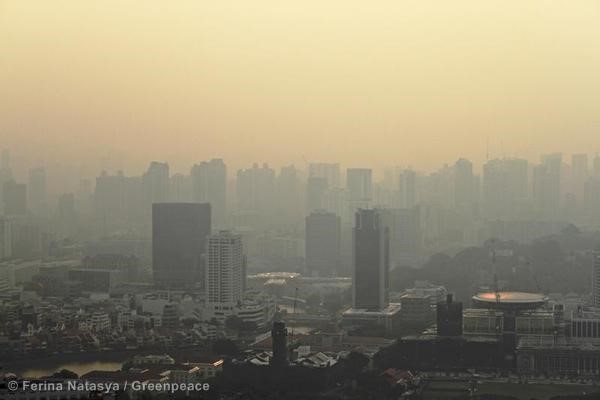The inevitable end of coal power has been known by policymakers and project developers for decades, and was formalized by the ratification of the Paris Agreement in 2015. Yet while countries around the world have made huge strides towards renewable energy solutions, new fossil fuel power plants that have no place in 2020 or beyond are still being built.
How Southeast Asia meets growing energy demand is a crucial challenge in the fight against climate change. These countries have not historically been the worst offenders in global emissions at less than 3%.1 But they have long relied on fossil fuels, especially coal and gas power, whose controlling economic interests have embedded themselves deep into political structures. Moreover, they will witness one of the biggest historical jumps in greenhouse gas emissions in the next ten years.2 Now is the time to change course.
Investment in renewable energy — wind and solar in particular — impacts job creation and other baseline economic indicators positively, as well as the transformation of energy systems. Government spending on renewable energy has been proven to create nearly three times more jobs than coal and gas.3 And because some renewable energy technologies, like solar, are much faster to market than coal (as solar projects have less overhead, start construction earlier and finish and go online faster), renewable energy investment is an ideal and relatively immediate vehicle for economic development. Renewable energy is analyzed here as both a tool for fast recovery from economic crises such as Covid-19 and a means to build better performing, more resilient economies.
All of the countries of Southeast Asia are party to the Paris Agreement. And each has acknowledged both the imperative to keep global temperature rise below 2 degrees Celsius in this century and the importance of pursuing a 1.5 degrees Celsius target. Regionally, the challenge of keeping below 1.5 degrees cannot be more urgent and should not be underestimated.
The region is one of the world’s most vulnerable to the impacts of climate change, according to the Global Climate Risk Index 2020, with four Southeast Asian countries in the top ten most vulnerable (Myanmar, the Philippines, Vietnam, and Thailand).4 Impacts include coastal flooding and extreme weather events, among others, that risk the livelihoods of people across Southeast Asia. To this end, the region is also home to leading campaigns for climate justice and liability that work to hold governments and fossil fuel companies accountable for climate-related risks. This work has already provided further incentive to abandon fossil fuel generation, including the impending resolution to the climate change inquiry conducted by the Philippines Commission on Human Rights that will determine whether fossil fuel companies have legal and moral responsibility to act on the climate crisis.5
In 2018, the Intergovernmental Panel on Climate Change (IPCC) brought together nearly 100 scientists to map out a 1.5 degrees pathway and to substantiate the difference between 1.5 and 2 degrees warming.6 They laid out targets for where the world would need to be by 2030, 2040, and 2050 in order to be on a 1.5 degrees pathway and found that coal power has no future in these targets. In order to meet the necessary threshold, coal will need to reduce sharply by 80 percent (from 2010 levels) by 2030, meaning any coal-fired power plant (CFPP) built today goes directly against that pathway.7
This report will analyze the progress of eight countries’ energy plans against this backdrop. As the development and progress of each country in the region vary substantially, this report will also compare the progress of countries against each other. This report will also present a model of electricity generation with two scenarios – a Business as Usual (BAU) Case and a Best Renewable Energy (RE) Case. The BAU Case is each country’s energy mix based on and extrapolated data from current Power Development Plans (PDPs). The Best RE Case prioritizes solar and wind and focuses on a least-cost pathway to meet the same projected generation needs.
READ THE FULL REPORT HERE
REFERENCES:
1. Ritchie, Hannah. “Who Has Contributed Most to Global CO2 Emissions?” Our World in Data, 2019, ourworldindata.org/ contributed-most-global-co2.
2. “Boiling Point.” The Impact of Climate Change in Southeast Asia – IMF Finance & Development Magazine, 2018, www.imf.org/ external/pubs/ft/fandd/2018/09/southeast-asia-climate-change- and-greenhouse-gas-emissions-prakash.htm.
3. “How a Post-Pandemic Stimulus Can Both Create Jobs and Help the Climate.” McKinsey & Company, 27 May 2020, www. mckinsey.com/business-functions/sustainability/our-insights/ how-a-post-pandemic-stimulus-can-both-create-jobs-and-help- the-climate.
4. “Global Climate Risk Index.” GermanWatch, Dec. 2019, germanwatch.org/sites/germanwatch.org/files/20-2-01e Global Climate Risk Index 2020_14.pdf.
5. “Philippines Commission on Human Rights Finds Fossil Fuel;Companies Have Legal and Moral Responsibility to Act on Climate Crisis.” Oxfam International, 11 Dec. 2019, www.oxfam.org/ en/press-releases/philippines-commission-human-rights-finds- fossil-fuel-companies-have-legal-and-moral.
6. Levin, Kelly. “8 Things You Need to Know About the IPCC 1.5 ̊C Report.” World Resources Institute, 10 Oct. 2018, www.wri.org/ blog/2018/10/8-things-you-need-know-about-ipcc-15-c-report.
7. “Global and Regional Coal Phase-out Requirements of the Paris Agreement: Insights from the IPCC Special Report on 1.5°C.” Climate Analytics, 2019, climateanalytics.org/media/report_coal_ phase_out_2019.pdf.

End the air pollution crisis once and for all, because no-one should have to worry about what they breathe.
Get Involved


